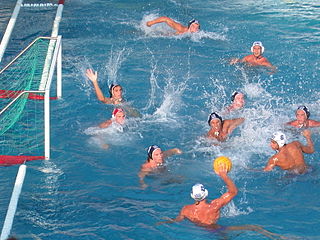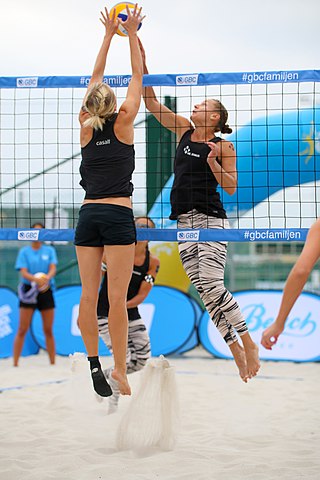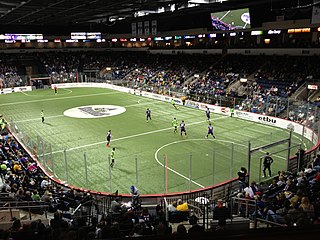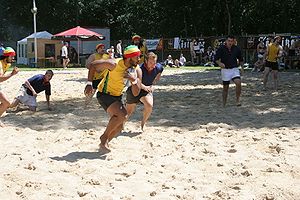Rules
In Beach rugby, rucks, mauls, scrums, gang tackles, kicks above waist heights, lineouts are outlawed.
Field dimensions
The size of a beach rugby field depends on the decision of the league. The field is between 30 and 50 metres long and 20–35 metres wide, and the in-goals are 3–7 metres deep. There are no goalposts on the field, and the lines are usually marked with some sort of tape or rope.
Number of players
Depending on the league and the field size, either 4 or 7 players are allowed on the field for one team at once. Between 3 and 7 reserves are allowed, again, depending on the league. Substitutions are often done "on-the-fly," similar to ice hockey or futsal.
The ball
A standard rugby ball is used, but many leagues will use a size 4 ball instead of size 5, the size used in all levels of field rugby above youth. A rugby ball is oval-shaped and made of synthetic leather panels that have small dimples to enhance handling.
Scoring
Most leagues use a "one try, one point" scoring system, since there are no goalposts on the field. Occasionally, a sudden-death extra time period is used to resolve matches drawn at the end of regulation, but not all leagues use this rule.
One Italian league used a system where the in-goals were divided into five equal rectangles. A try scored from the outer rectangles was worth 3 points, from the central rectangle was 5 points, and from either of the two intermediate rectangles was worth 4 points. However, there is no evidence that this league still exists. The Ameland Beach Rugby Festival www.beachrugby.nl(The Netherlands) also uses this system.
Timing
Leagues use either two 5 or 7 minute halves (with a 1 or 3 minute interval for halftime) as the length of a single match. Extra time may be played if the league in question calls for it.

Gaelic football, commonly known as simply Gaelic, GAA or Football is an Irish team sport. A form of football, it is played between two teams of 15 players on a rectangular grass pitch. The objective of the sport is to score by kicking or punching the ball into the other team's goal or between two upright posts above the goal and over a crossbar 2.5 metres above the ground.

Water polo is a competitive team sport played in water between two teams of seven players each. The game consists of four quarters in which the teams attempt to score goals by throwing the ball into the opposing team's goal. The team with the most goals at the end of the game wins the match. Each team is made up of six field players and one goalkeeper. Excluding the goalkeeper, players participate in both offensive and defensive roles. It is typically played in an all-deep pool where players cannot touch the bottom.

Beach volleyball is a team sport played by two teams of two or more players on a sand court divided by a net. Similar to indoor volleyball, the objective of the game is to send the ball over the net and to ground it on the opponent's side of the court. Each team also works in unison to prevent the opposing team from grounding the ball on their side of the court.

In sport, a goal may refer to either an instance of scoring, or to the physical structure or area where an attacking team must send the ball or puck in order to score points. The structure of a goal varies from sport to sport, and one is placed at or near each end of the playing field for each team to defend. For many sports, each goal structure usually consists of two vertical posts, called goal posts, supporting a horizontal crossbar. A goal line marked on the playing surface between the goal posts demarcates the goal area. Thus, the objective is to send the ball or puck between the goal posts, under or over the crossbar, and across the goal line. Other sports may have other types of structures or areas where the ball or puck must pass through, such as the basketball hoop. Sports which feature goal scoring are also commonly known as invasion games.

Indoor soccer or arena soccer is a five-a-side or six-a-side version of minifootball, derived from association football and adapted to be played in walled hardcourt indoor arena. Indoor soccer, as it is most often known in the United States and Canada, was originally developed in these two countries as a way to play soccer during the winter months, when snow would make outdoor play difficult. In those countries, gymnasiums are adapted for indoor soccer play. In other countries the game is played in either indoor or outdoor arenas surrounded by walls, and is referred to by different names.
Overtime or extra time is an additional period of play specified under the rules of a sport to bring a game to a decision and avoid declaring the match a tie or draw where the scores are the same. In some sports, this extra period is played only if the game is required to have a clear winner, as in single-elimination tournaments where only one team or players can advance to the next round or win the tournament and replays are not allowed.
The penalty shootout is a method of determining a winner in sports matches that would have otherwise been drawn or tied. The rules for penalty shootouts vary between sports and even different competitions; however, the usual form is similar to penalty shots in that a single player takes one shot on goal from a specified spot, the only defender being the goalkeeper. If the result is still tied, the shootout usually continues on a "goal-for-goal" basis, with the teams taking shots alternately, and the one that scores a goal unmatched by the other team is declared the winner. This may continue until every player has taken a shot, after which players may take extra shots, until the tie is broken, and is also known as "sudden death".

Footvolley is a sport that combines aspects of beach volleyball and association football.

Beach soccer, also known as beach football, sand football or beasal, is a variant of association football played on a beach or some form of sand.

A football pitch is the playing surface for the game of association football. Its dimensions and markings are defined by Law 1 of the Laws of the Game, "The Field of Play". The pitch is typically made of natural turf or artificial turf, although amateur and recreational teams often play on dirt fields. Artificial surfaces are allowed only to be green in colour.
Speedball is a fast-paced sport that combines many aspects of other sports. Points are scored by throwing or kicking the ball into the opposing goal. It is played with two teams of at most five, each with one goalie on a basketball court or soccer field.

A comparison of American football and rugby union is possible because of the games' shared origins, despite their dissimilarities.
A comparison between American football and rugby league is possible because of their shared origins and similar game concepts. Rugby league is arguably the most similar sport to American football after Canadian football: both sports involve the concept of a limited number of downs/tackles and scoring touchdowns/tries takes clear precedence over goal-kicking.
Several sports related to volleyball have become popular. Indoor volleyball and beach volleyball are both events at the Olympics, and sitting volleyball is an event at the Paralympics. Other varieties are localized, or are played at an amateur or informal level.

A penalty shot or penalty kick is a play used in several sports whereby a goal is attempted during untimed play. Depending on the sport, when a player commits certain types of penalties, the opposition is awarded a penalty shot or kick attempt. The rules on how a player attempts a penalty shot or kick also varies between sports.
The following is an alphabetical list of terms and jargon used in relation to Gaelic games. See also list of Irish county nicknames, and these are very interesting.
In team sports, substitution is replacing one player with another during a match. Substitute players that are not in the starting lineup reside on the bench and are available to substitute for a starter. Later in the match, that substitute may be substituted for by another substitute or by a starter who is currently on the bench.
Variations of Australian rules football are games or activities based on or similar to the game of Australian rules football, in which the player uses common Australian rules football skills. They range in player numbers from 2 up to the minimum 38 required for a full Australian rules football.

A comparison of Gaelic football and rugby union is possible because of certain similarities between the codes, as well as the numerous dissimilarities.

Comparison of association football (football/soccer) and rugby union is possible because of the games' similarities and shared origins.












